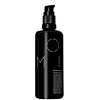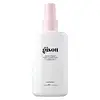What's inside
What's inside
 Key Ingredients
Key Ingredients

 Benefits
Benefits

 Concerns
Concerns

 Ingredients Side-by-side
Ingredients Side-by-side

Water
Skin ConditioningCetearyl Alcohol
EmollientDicaprylyl Carbonate
EmollientBehentrimonium Methosulfate
Yeast Extract
Skin ConditioningChitosan Succinamide
Cetyl Esters
EmollientHydrolyzed Sweet Almond Protein
Skin ConditioningPentaclethra Macroloba Seed Oil
EmollientButyrospermum Parkii Butter
Skin ConditioningCitrus Aurantium Bergamia Peel Oil
Lavandula Dentata Flower/Leaf Oil
MaskingZingiber Officinale Root Oil
MaskingSantalum Spicata Wood Oil
PerfumingDehydroacetic Acid
PreservativeLaurus Nobilis Leaf Oil
MaskingOlea Europaea Leaf Extract
PerfumingRosmarinus Officinalis Leaf Extract
AntimicrobialEugenia Caryophyllus Bud Oil
MaskingPogostemon Cablin Leaf Oil
MaskingSodium PCA
HumectantSalvia Officinalis Leaf Oil
Sodium Lactate
BufferingHelianthus Annuus Seed Oil
EmollientFoeniculum Vulgare Seed
Skin ConditioningArginine
MaskingJasminum Sambac Flower Oil
MaskingAspartic Acid
MaskingPiper Nigrum Fruit Oil
MaskingPCA
HumectantVanilla Planifolia Fruit Oil
EmollientVetiveria Zizanoides Root Oil
MaskingGlycine
BufferingAvena Sativa Bran Extract
AbrasiveRosa Damascena Flower Oil
MaskingAlanine
MaskingMentha Aquatica Leaf Oil
MaskingSerine
MaskingValine
MaskingIsoleucine
Skin ConditioningThreonine
Proline
Skin ConditioningPhenylalanine
MaskingHistidine
HumectantSodium Benzoate
MaskingPotassium Sorbate
PreservativeBenzyl Alcohol
PerfumingLinalool
PerfumingLimonene
PerfumingEugenol
PerfumingCitral
PerfumingEstagole
Geraniol
PerfumingWater, Cetearyl Alcohol, Dicaprylyl Carbonate, Behentrimonium Methosulfate, Yeast Extract, Chitosan Succinamide, Cetyl Esters, Hydrolyzed Sweet Almond Protein, Pentaclethra Macroloba Seed Oil, Butyrospermum Parkii Butter, Citrus Aurantium Bergamia Peel Oil, Lavandula Dentata Flower/Leaf Oil, Zingiber Officinale Root Oil, Santalum Spicata Wood Oil, Dehydroacetic Acid, Laurus Nobilis Leaf Oil, Olea Europaea Leaf Extract, Rosmarinus Officinalis Leaf Extract, Eugenia Caryophyllus Bud Oil, Pogostemon Cablin Leaf Oil, Sodium PCA, Salvia Officinalis Leaf Oil, Sodium Lactate, Helianthus Annuus Seed Oil, Foeniculum Vulgare Seed, Arginine, Jasminum Sambac Flower Oil, Aspartic Acid, Piper Nigrum Fruit Oil, PCA, Vanilla Planifolia Fruit Oil, Vetiveria Zizanoides Root Oil, Glycine, Avena Sativa Bran Extract, Rosa Damascena Flower Oil, Alanine, Mentha Aquatica Leaf Oil, Serine, Valine, Isoleucine, Threonine, Proline, Phenylalanine, Histidine, Sodium Benzoate, Potassium Sorbate, Benzyl Alcohol, Linalool, Limonene, Eugenol, Citral, Estagole, Geraniol
Water
Skin ConditioningBehenamidopropyl Dimethylamine
EmulsifyingCetearyl Alcohol
EmollientLactic Acid
BufferingAdansonia Digitata Seed Oil
EmollientArgania Spinosa Kernel Oil
EmollientMel
EmollientSodium Benzoate
MaskingHydroxypropyltrimonium Honey
Panthenol
Skin ConditioningParfum
MaskingHydrolyzed Wheat Protein
Skin ConditioningHydrolyzed Adansonia Digitata Seed Extract
Benzyl Alcohol
PerfumingSaccharomyces/Magnesium Ferment
Sorbic Acid
PreservativeSaccharomyces/Iron Ferment
Skin ConditioningPotassium Sorbate
PreservativeSaccharomyces/Zinc Ferment
Skin ConditioningSaccharomyces/Copper Ferment
Skin ConditioningSaccharomyces/Silicon Ferment
Skin ConditioningCoumarin
PerfumingHexyl Cinnamal
PerfumingLimonene
PerfumingLinalool
PerfumingWater, Behenamidopropyl Dimethylamine, Cetearyl Alcohol, Lactic Acid, Adansonia Digitata Seed Oil, Argania Spinosa Kernel Oil, Mel, Sodium Benzoate, Hydroxypropyltrimonium Honey, Panthenol, Parfum, Hydrolyzed Wheat Protein, Hydrolyzed Adansonia Digitata Seed Extract, Benzyl Alcohol, Saccharomyces/Magnesium Ferment, Sorbic Acid, Saccharomyces/Iron Ferment, Potassium Sorbate, Saccharomyces/Zinc Ferment, Saccharomyces/Copper Ferment, Saccharomyces/Silicon Ferment, Coumarin, Hexyl Cinnamal, Limonene, Linalool
Ingredients Explained
These ingredients are found in both products.
Ingredients higher up in an ingredient list are typically present in a larger amount.
Benzyl Alcohol is most commonly used as a preservative. It also has a subtle, sweet smell. Small amounts of Benzyl Alcohol is not irritating and safe to use in skincare products. Most Benzyl Alcohol is derived from fruits such as apricots.
Benzyl Alcohol has both antibacterial and antioxidant properties. These properties help lengthen the shelf life of products. Benzyl Alcohol is a solvent and helps dissolve other ingredients. It can also improve the texture and spreadability.
Alcohol comes in many different forms. Different types of alcohol will have different effects on skin. This ingredient is an astringent alcohol.
Using high concentrations of these alcohols are drying on the skin. They may strip away your skin's natural oils and even damage your skin barrier. Astringent alcohols may also irritate skin.
Other types of astringent alcohols include:
According to the National Rosacea Society based in the US, you should be mindful of products with these alcohols in the top half of ingredients.
Any type of sanitizing product will have high amounts of alcohol to help kill bacteria and viruses.
Learn more about Benzyl AlcoholCetearyl alcohol is a mixture of two fatty alcohols: cetyl alcohol and stearyl alcohol. It is mainly used as an emulsifier. Emulsifiers help prevent the separation of oils and products. Due to its composition, it can also be used to thicken a product or help create foam.
Cetearyl alcohol is an emollient. Emollients help soothe and hydrate the skin by trapping moisture.
Studies show Cetearyl alcohol is non-toxic and non-irritating. The FDA allows products labeled "alcohol-free" to have fatty alcohols.
This ingredient is usually derived from plant oils such as palm, vegetable, or coconut oils. There is debate on whether this ingredient will cause acne.
Due to the fatty acid base, this ingredient may not be Malassezia folliculitis safe.
Learn more about Cetearyl AlcoholLimonene is a fragrance that adds scent and taste to a formulation.
It's found in the peel oil of citrus fruits and other plants such as lavender and eucalyptus. The scent of limonene is generally described as "sweet citrus".
Limonene acts as an antioxidant, meaning it helps neutralize free radicals.
When exposed to air, oxidized limonene may sensitize the skin. Because of this, limonene is often avoided by people with sensitive skin.
The term 'fragrance' is not regulated in many countries. In many cases, it is up to the brand to define this term. For instance, many brands choose to label themselves as "fragrance-free" because they are not using synthetic fragrances. However, their products may still contain ingredients such as essential oils that are considered a fragrance.
Learn more about LimoneneLinalool is a fragrance and helps add scent to products. It's derived from common plants such as cinnamon, mint, citrus, and lavender.
Like Limonene, this ingredient oxidizes when exposed to air. Oxidized linalool can cause allergies and skin sensitivity.
This ingredient has a scent that is floral, spicy tropical, and citrus-like.
Learn more about LinaloolPotassium Sorbate is a preservative used to prevent yeast and mold in products. It is commonly found in both cosmetic and food products.
This ingredient comes from potassium salt derived from sorbic acid. Sorbic acid is a natural antibiotic and effective against fungus.
Both potassium sorbate and sorbic acid can be found in baked goods, cheeses, dried meats, dried fruit, ice cream, pickles, wine, yogurt, and more.
You'll often find this ingredient used with other preservatives.
Learn more about Potassium SorbateSodium Benzoate is a preservative. It's used in both cosmetic and food products to inhibit the growth of mold and bacteria. It is typically produced synthetically.
Both the US FDA and EU Health Committee have approved the use of sodium benzoate. In the US, levels of 0.1% (of the total product) are allowed.
Sodium benzoate works as a preservative by inhibiting the growth of bacteria inside of cells. It prevents the cell from fermenting a type of sugar using an enzyme called phosphofructokinase.
It is the salt of benzoic acid. Foods containing sodium benzoate include soda, salad dressings, condiments, fruit juices, wines, and snack foods.
Studies for using ascorbic acid and sodium benzoate in cosmetics are lacking, especially in skincare routines with multiple steps.
We always recommend speaking with a professional, such as a dermatologist, if you have any concerns.
Learn more about Sodium BenzoateWater. It's the most common cosmetic ingredient of all. You'll usually see it at the top of ingredient lists, meaning that it makes up the largest part of the product.
So why is it so popular? Water most often acts as a solvent - this means that it helps dissolve other ingredients into the formulation.
You'll also recognize water as that liquid we all need to stay alive. If you see this, drink a glass of water. Stay hydrated!
Learn more about Water